Complete Puppy Feeding Guide: How Much, When & What to Feed Your New Puppy (2025)
Your puppy's nutrition in their first year shapes their entire life. Get it right from the start.
Bringing home a new puppy is one of life's greatest joys—but it also comes with big responsibilities. What you feed your puppy and how much doesn't just affect their growth; it impacts their development, behavior, immune system, and long-term health. Research from major pet nutrition companies shows that feeding decisions made during puppyhood affect growth, development, and even behavior patterns.
Learn the essentials of puppy nutrition with our comprehensive guide covering meal frequency, portion sizes, and food types. We'll walk you through breed-specific feeding requirements, safe superfood additions, and monitoring tips to support your puppy's healthy growth—all designed to complement your veterinarian's guidance for the best start in life.

ON THIS PAGE
Getting a new puppy is exciting, but figuring out their feeding needs can feel overwhelming. How much food is too much? When should you feed them? What foods are actually safe?
This complete puppy feeding guide answers all your questions with science-backed advice that's easy to follow. You'll learn exactly how much to feed your puppy, the best feeding schedules, and which foods will help them grow into healthy adult dogs.
🧬 Why Proper Puppy Nutrition Matters More Than You Think
Your puppy isn't just getting bigger—they're undergoing rapid development that requires precise nutrition. During their first year, they'll transform from a tiny newborn to a fully grown adult dog.
Here's what makes puppy nutrition so critical:
⚡ High energy needs: Puppies need 2-3 times more energy per kg body weight than adult dogs
🥩 Protein for growth: Growing puppies need about 25% of their daily calories from protein
🦴 Bone development: The right balance of calcium and phosphorus prevents development of future joint problems
🧠 Brain power: DHA supports cognitive development and vision
❌ Common feeding mistakes that hurt your puppy's health:
- Overfeeding (leads to joint problems due to weight gain, especially in large breeds)
- Switching to adult food too early (robs puppies of growth nutrients)
- Irregular meal times (disrupts digestion and house training)
- Wrong portion sizes based on current weight instead of adult size
📏 How Much Should I Feed My Puppy? (Feeding Chart by Weight)
The amount you feed depends on your puppy's current weight and expected adult size.
🧮 Quick Puppy Portion Calculator
Use this veterinary-approved RER/MER formula:
Step 1: Calculate RER (Resting Energy Requirement)
RER = 70 × (current body weight in kg)^0.75
Step 2: Calculate MER (Maintenance Energy Requirement)
- For puppies 0-4 months: MER = RER × 3.0
- For puppies 4-12 months: MER = RER × 2.5
- For large breed puppies >4 months: MER = RER × 2.0
Step 3: Convert to food portions
- Divide MER by calories per cup of your chosen food
- Split into appropriate meals based on age
📊 Example: 3-month-old puppy weighing 8 kg:
- RER = 70 × (8)^0.75 = 70 × 5.66 = 396 calories
- MER = 396 × 3.0 = 1,188 calories daily
- If food has 400 cal/cup: 1,188 ÷ 400 = 3 cups daily
- Split into 3 meals = 1 cup per meal
⚖️ Always adjust based on your puppy's body condition and activity level
You can use online calorie calculator tools like this, to easily calculate your pups calorie requirements.
🕐 Puppy Feeding Schedule by Age: The 4-Meal System

Most veterinary nutritionists recommend four meals a day for young puppies. Here's why this works so well:
🔸 Small stomachs: Puppies can't eat large amounts at once
🔸 Fast metabolism: They need consistent energy every 4-6 hours
🔸 Stable blood sugar: Prevents dangerous drops, especially in small breeds
🔸 Better digestion: Smaller meals are easier to process
⏰ Feeding Schedule by Age
| Age | Meals Per Day | Time Between Meals | Notes |
|---|---|---|---|
| 8-16 weeks | 4 meals | Every 4-6 hours | Critical growth phase |
| 4-6 months | 3 meals | Every 6-8 hours | Start reducing frequency |
| 6+ months | 2 meals and a snack | Every 12 hours | Adult pattern begins |
📅 Sample Daily Feeding Schedule
🌅 7:00 AM - Morning meal (energy for active day)
☀️ 12:00 PM - Lunch (midday fuel)
🌤️ 4:00 PM - Afternoon meal (prevents evening hunger)
🌙 7:00 PM - Dinner (digestible evening portion)
💡 Pro tip: Feed at the same times every day to establish routine and help with house training.
🎯 Why Scheduled Feeding Works Better Than Free-Feeding
Scheduled meals provide several benefits:
- Support consistent digestion
- Aid house-training success
- Prevent overeating and puppy obesity
- Allow monitoring of appetite changes
🍽️ Best Food Types for Puppies: Dry, Wet, or Homemade?
🥗 Dry Kibble (Most Popular Choice)
Benefits:
- Convenient and economical
- Supports dental health through chewing
- Easy to measure portions
- Long shelf life
How to choose: Look for AAFCO-approved formulas with real meat as the first listed ingredient. Avoid foods with excessive fillers or by-products.
Daily amount: Based on your pups calculated calorie requirements.
🥫 Wet Food (Great for Hydration)
Benefits:
- More appealing to picky eaters
- Higher moisture content
- Easier for very young puppies
- Can help with hydration
Daily amount: Based on your pups calculated calorie requirements.
💰 Money-saving tip: Mix 25% wet food with 75% dry kibble to get benefits of both while controlling costs.
👨🍳 Homemade Meals (Advanced Option)
Benefits:
- Complete control over ingredients
- Fresh, whole food nutrition
- Good for puppies with allergies
⚠️ Important warning: Homemade puppy diets must meet AAFCO nutritional guidelines. Work with a veterinary nutritionist to ensure proper balance of calcium, phosphorus, and amino acids.
🥕 Safe Human Foods for Puppies: The 10% Superfood Rule
You can safely give your puppy certain human foods, but they should never exceed 10% of daily calories. The other 90% should come from complete puppy food.

🌟 Top 5 Puppy Superfoods
1. 🫐 Blueberries
- Benefits: Antioxidants, fiber, vitamins for immune health
- Amount: 2-3 berries a day for small puppies, 5-6 for medium, up to 10 for large breeds
- Perfect for: Training treats
2. 🐟 Cooked Salmon (boneless)
- Benefits: Omega-3 fatty acids for brain and eye development
- Amount: 1 tablespoon per 10 pounds of body weight
- Frequency: 2-3 times weekly
3. 🍠 Sweet Potato (cooked, no seasoning)
- Benefits: Beta-carotene, fiber, sustained energy
- Amount: 1 teaspoon for small puppies, 1 tablespoon for larger breeds
- Prep: Steam or bake, never raw
4. 🎃 Plain Pumpkin (canned, not pie filling)
- Benefits: Digestive health, helps with constipation and diarrhea
- Amount: 1 teaspoon to 2 tablespoons depending on size
- Great for: Food transitions and upset stomachs
5. 🥛 Plain Greek Yogurt (live cultures) (may not suit all puppies)
- Benefits: Probiotics for gut health, calcium, protein
- Amount: 1 teaspoon to 2 tablespoons depending on size
- Frequency: 2-3 times weekly
🛡️ Safe Introduction Rules
- One at a time: Introduce only one new food per week
- Start small: Use tiny amounts the first few times
- Watch closely: Monitor for 48 hours for digestive upset or allergic reactions
- Quality matters: Choose human-grade, organic when possible
📈 When to Switch from Puppy Food to Adult Food
This is one of the most common questions new dog owners ask. The timing depends entirely on your dog's size.
⏳ Transition Timeline by Breed Size
- Small breeds (under 10 kgs): 9-12 months
- Medium breeds (10-25 kgs): 12-15 months
- Large breeds (25-40 kgs): 15-18 months
- Giant breeds (Over 40 kgs): 18-24 months
✅ Signs It's Time to Switch
- Growth rate has slowed significantly
- Reached 80% of predicted adult weight
- Your veterinarian recommends the switch
- Less interest in puppy food
- Adult teeth are fully in
🔄 How to Transition Foods Safely
Never switch foods overnight. Use this 7-day transition plan:
- Days 1-2: 25% new food + 75% old food
- Days 3-4: 50% new food + 50% old food
- Days 5-6: 75% new food + 25% old food
- Day 7+: 100% new food
If your puppy gets an upset stomach, slow down the transition.
🏥 Monitoring Your Puppy's Health and Growth
📊 Weekly Health Checks
Weight monitoring:
- Weigh your puppy weekly for the first 6 months
- Use a digital scale or visit your vet
- Look for steady growth, not rapid weight gain
Body condition check:
- You should easily feel (but not see) your puppy's ribs
- There should be a visible waist when viewed from above
- Your puppy should be active and playful, not lethargic
⚠️ Red Flags That Need Vet Attention
- Rapid weight loss or gain
- Refusing food for more than 24 hours
- Persistent vomiting or diarrhea
- Lethargy or behavior changes
- Growth that seems too fast (especially concerning for large breeds)
💡 Pro Tips for Feeding Success
🎯 Creating Good Mealtime Habits
- Stick to schedule: Feed at the same times daily
- Quiet space: Let your puppy eat without distractions
- 15-minute rule: Remove uneaten food after 15 minutes
- No free-feeding: Structured meals prevent overeating and help with training
🎓 Using Food for Training
- Use kibble as treats: Take portions from daily allowance for training sessions
- High-value rewards: Save special treats for major training breakthroughs
- Train before meals: Hungry puppies are more motivated to learn
❓ FAQ: Common Puppy Feeding Questions
🍽️ How many times a day should I feed my puppy?
- 8-16 weeks old: 4 times per day
- 4-6 months old: 3 times per day
- 6+ months old: 2 times per day and include a small snack in the afternoon
Young puppies need frequent meals because they have small stomachs and fast metabolisms. As they grow, you can gradually reduce meal frequency.
🥕 Can I give my puppy human food?
Yes, but only certain foods and in small amounts. Safe options include blueberries, cooked salmon, sweet potato, plain pumpkin, and plain yogurt. Human food should never exceed 10% of your puppy's daily calories. 🚫 Never give puppies chocolate, grapes, onions, garlic, or foods with xylitol (artificial sweetener).
⚖️ How do I know if I'm feeding my puppy too much?
Signs of overfeeding include - rapid weight gain, can't easily feel ribs under a thin layer of fat, no visible waist when viewed from above, lethargy or reluctance to play, loose stools. If you notice these signs, reduce portion sizes and consult your veterinarian.
🚫 What should I do if my puppy won't eat?
First, don't panic. Try these steps:
- Make sure the food is fresh and hasn't spoiled
- Try warming the food slightly to enhance aroma
- Add a small amount of wet food or low-sodium broth
- Ensure you're feeding in a quiet, stress-free environment
- Remove food after 15 minutes and try again at the next scheduled meal
If your puppy refuses food for more than 24 hours, contact your veterinarian.
🏆 The Foundation for Lifelong Health
Proper puppy nutrition isn't just about surviving the first year—it's about building the foundation for your dog's entire life. The eating habits, digestive health, and growth patterns you establish now will benefit your dog for years to come.
Remember that every puppy is unique. While these guidelines provide an excellent starting point, always work with your veterinarian to create a feeding plan tailored to your specific puppy's needs, breed characteristics, and health status.
🔑 Key takeaway: Consistency, quality nutrition, and attention to your puppy's individual needs will set them up for a long, healthy, and happy life by your side.



